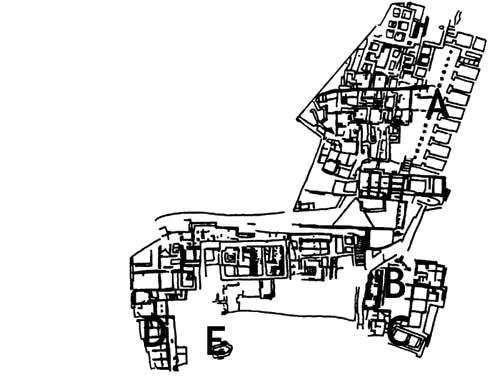Unpacking and publishing the Phaistos Disk since 1993
HOME | PREVIOUS | NEXT | SITEMAP




























The priests and priestesses of Thoth, believing that ultimate reality is numerical, that number is the key to the universe, that triangles are the fundamental building blocks of the cosmos and that geometry is the Sacred Science, instructed their initiates in three divine areas of thought: Sacred Geometry, astronomy and philosophy. The numbers 60 and 5 were particularly sacred to their Religion of the Mind.
The 30 line segments of each side of the Phaistos Disk total the sacred number 60. (One of the segments on Side 1, rather than being a line segment, is a long thyrsuses, the tall symbolic wand made from cane or bamboo.) The number 60, in Hermetic literature of a much later period but said to have originated in ancient Egypt, represents the number of subordinate orders of the 3 divisions of the main cosmos, of which "there is an orderly harmonius movement of one to the other." (1) In the microcosm and corresponding to this macrocosmic arrangement are 4 main divisions of soul-stuff with 60 soul-spaces, called zones, firmaments or layers, comprising the 60 types of souls.
And in these sixty spaces dwell the souls, each one according to its nature, for though they are of one and the same substance, they're not of the same dignity. (2)
The 60 soul types are layered in the Vast Vortex, the Crater or Cup that is the curtain of space-time and energy-matter. When the World Soul glyph that represents this curtain or veil is viewed from above, it appears as concentric circles. Around the edges of the circular vortex, the souls, sinking down, "flutter round the vortex in a circle, not daring to go straight through it." (3) The Mighty Whirlpool, the Mixing Bowl of the Creator, the within-without of the Shamanic tunnel and the mystical Spiral of Creation are all symbolized by the Phaistos Disk. The vortex, a rotating movement of cosmic matter round a center or axis, accounts for the origin or phenomenon of the terrestrial and other systems. The 60 soul spaces and the vortex are visible on the Phaistos Disk, Sides 1 and 2, when the signs have been removed. This spiral may also represent of the spiral movement of the star Sirius through the constellations.
The idea of the Cup or Mixing Bowl or the curtain of space-time and energy-matter as concentric circles or as round maze, "did not owe its origin to any invention of Plato's (427-347? BCE), but that the greatest of philosophers, when he makes use of the symbol, does but employ a familiar image well known to his audience...the symbol or image was a commonplace of the Orphic tradition, and doubtless, therefore, familiar to every Pythagorean." (4)
The vortex is also vertex, meaning "to turn or rotate." The vertex is the zenith, the point in the heavens directly overhead, represented by the flax flower on Side 1 and the triangle fruit and the Nile signs on Side 2 of the disk. The Pythagoreans, who got their science from Egypt, understood the vertex to mean the point opposite to and farthest from the base of a triangle, pyramid, or any figure having a base. Geometry thus originated with the study of the vertex-vortex and involved, pre-eminently, the triangle and its uses in describing the properties of a circle and the geometry of the sphere for use in astronomy.
The triangle is the ancient Three Primordial Principles as expressed in geometry. The triangle is "sacred" because it represents the "plain of truth," the "hearth of the universe" and thesis-antithesis-synthesis. Gnosis is beyond reach unless one's feet have crossed the "plain of truth," meaning the study of Sacred Geometry and the triangle, particularly the magic 3-4-5 triangle.
The sacred 60 is also significant because long before 1600 BCE the 60-system of counting was used by the Mesopotamians, who were avid astronomers as were the Egyptians. The application of the sexagesimal (60-system) system in astronomy was continued by Greek and Hindu astronomers until about 500 CE. Since most of the constellation names originated in Crete and Greece, it is safe to say that because of the symbols on the disk and the knowledge of the use of the 60-system by Greek astronomers much later, the 60-system was employed by the Cretans in their astronomical calculations. The three 60's--the 60 soul types of the vertex-vortex, the 60 of the 3-4-5 triangle (3x4=12x5=60), and the 60-system of counting in astronomy--are inseparable syncretisms, in terms of symbolisms found on the disk.
And they (crocodiles of the Nile) lay sixty [eggs] and hatch them out in as many days, and the longest-lived of them live as many years-which is the first of the measures for those who treat systematically of celestial [phenomena]. (5)
That is (re: the celestial phenomena), presumably, either the 60 of the Chaldaeans, or the 3x4x5 of the 'most perfect' triangle of the Mathematici. (6)
The most perfect triangle, the right triangle, has its perpendicular [side] of 'three', its base of 'four,' and its hypotenuse of 'five...' (7)
And one might conjecture the Egyptians [also revered] the fairest of triangles, likening the nature of the universe especially to this... (8)
The Egyptians, millennia before Pythagoras, employed the magic 3-4-5 triangle of the Pythagorean Theorem, c2=a2+b2. The result, 25, was the number of letters in the Egyptian alphabet. (9)
And five makes a square equal to the number of letters among Egyptians, and a period of as many years as the Apis lives. (10)
Again, by the relative position of its (the ibis') legs to one another, and [of those] to its beak, it forms an equilateral triangle... (12)
The Phaistos Disk is one of the oldest artifacts, and certainly the most unique, recording the study of geometry and astronomy. In Euclidean geometry (300 BCE), as taught by Euclid in Alexandria, Egypt, the number one is represented as a point and defined as that which has no part. The number one is represented on the disk by 10 unrepeated signs, five signs on Side 1 and five signs on Side 2. The five unrepeated pictographs on Side 1 are the pig, the starship, Osiris and Shield, the Great Dog and the Nile crab. On Side 2 they are the ram (sacred sheep), Pan, the crescent-shaped coffin, the hatchet of Typhon and the equilateral triangle.
The number two is represented by a straight line, having an angle of 180 degrees and a length defined as magnitude. "A line is a breadthless length." (13) The straight line may be the diameter of a circle, Parallel straight lines are straight lines which, being in the same plane and being produced indefinitely in both directions, do not meet one another in either direction. (15) Two or more straight lines, having no points in common, may be parallel and of the same magnitude Two straight lines may intersect, producing vertical angles. Two straight lines may produce adjacent angles Rectilineal figures are those which are contained by straight lines, trilateral figures being those contained by three, quadrilateral those contained by four, and multilateral those contained by more than four straight lines.
Of trilateral figures, an equilateral triangle "Further, of trilateral figures, a right angled triangle" Quadrilateral figures are contained by four straight lines. Many of the patterns on the disk probably are constellations of the Northern and Southern Hemispheres as they appeared 3,600 years ago. Seen on Side 2 are Orion Among the constellations on Side 1 are Octans The concealed heptagram of the Phaistos Disk is part of the ancient Osirian religion-science founded on the vertex-vortex and a geometry-based number philosophy, correlated herein to the 13 portals of the curtain of space-time and energy-matter. The number philosophy and the heptagram illustrate "the development of the method of 'exhaustion,' which shows how to 'exhaust' the area of a circle by means of an inscribed polygon; if we successively double the number of sides in the polygon, we will eventually reduce the difference between the area of the polygon (known) and the area of the circle (unknown) to the point where it is smaller than any magnitude we choose. This method made it possible to calculate the area of a circle to any desired degree of accuracy; with a little further development, it could be used to calculate the area within (or under) other curves as well" (18) and to calculate "the area bounded by certain spirals, and the surface area and volume of a sphere. (19)
The method of exhaustion was "probably borrowed by Euclid from his predecessor Eudoxus," (20) (400-355 BCE), a Greek astronomer and mathematician credited with this inventive method of calculating proportion. The Phaistos Disk seems to show exhaustion in use 1200 years before Eudoxus.
The number philosophy makes of a circle, in the mystical sense, an alchemical vessel, a Mixing Bowl, in which can be seen and analyzed the alchemical stages in the action of the Absolute in differentiating Self into a phenomenal universe through geometry. Each alchemical stage is introduced with 1-13 of the 13 precepts of the Emerald Table of Hermes Trismegistus, a legendary alchemical enigma and text puzzle.
Various cultures claim to have discovered the Emerald Table-"Tabula Smaragdina." In one account of discovery, Alexander the Great found the table in the tomb of Hermes (Thoth). In another account, Sarah the wife of the biblical Abraham, found the entombed Hermes holding in his hands his table. Alternately, the precepts may have been written in Syriac.
These precepts of Hermes were cherished with a kind of religious fervour by the adepts (of alchemy), who looked upon them as summarising in a concealed form the fundamental secrets of alchemy and of the Philosopher's Stone. (21)
Precept 1. "I speak not fictitious things, but that which is certain and true. The point within the circle, Precept 2. "What is below is like that which is above, and that which is above is like that which is below, to accomplish the miracles of one thing. The cross within the circle is P2. Precept 3. "And as all things are produced by the one word of one Being, so all things were produced from this one thing by adaptation. The triangle within the circle is P3. Precept 5. "It is the father of perfection throughout the world. The pentagon and pentagram are P5. Precept 6. "The power is vigorous if it be changed into earth." The hexagon and hexagram are P6. Precept 7. "Separate the earth from the fire, the subtle from the gross, acting prudently and with judgment. The heptagon and heptagrams are P7. "Only [the Hermetic Star] indicated the science of its owner by this characteristic sign of the Work, the one and only star. All those who undertake the Work seek to obtain the Star." (Nicholas Rollin, 1447 CE)
Precept 8. "Ascend with the greatest sagacity from the earth to heaven, and then again descend to the earth, and unite together the powers of things superior and things inferior. Thus you will obtain the glory of the whole world, and obscurity will fly far away from you." The octagon and octagrams are P8. Precept 9. "This has more fortitude than fortitude itself, because it conquers every subtle thing and can penetrate every solid. The enneagon and the enneagrams are P9. Precept 10. "Thus was the world formed. The dekagon and the dekagrams are P10. Precept 11. "Hence proceed wonders, which are here established." The endekagon and the endekagrams are P11. Precept 12. "Therefore, I am called Hermes Trismegistus, having three parts of the philosophy of the whole world." The dodekagon and the dodekagrams are P12. Precept 13. "That which I had to say concerning the operation of the sun is completed." P13 is the fully corporeal universe.
The Sirians in the starship flew directly over Mali in Africa on a flight plan taken from the disk that reads "Nazca Plain-Cheops."
On other Nazca pottery is interesting vertical mining equipment with a conveyer belt for sorting sand and rock, operated by some unusual miners with strange power supplies. (left)
When the monotony of flying the dead straight lines (below left) on automatic pilot became too much, the creative miners made a variety of gigantic designs in the soil. (below right) Almost all of the dozens of animals on the plain are drawn in continuous lines, so that the outline of each animal can be walked like a maze. The designs may be alien animals of the zodiac (meaning circle of animals) of other, more distant skies.
Some of the Sirians may have arrived here in a space shuttle (above) designed like the Hagia Triada palace (1600 BCE) of Crete (above top), which covered about 5-1/2 acres. The palace sports a tail wing with ailerons (A), a rear end rocket engine (B), a rear photon gun (C), a flight of steps for entering/exiting (D) and a luggage tram. (E) The palace seems to be a record in stone of a disembarkment that took place in Crete thousands of years ago.
1. "The Virgin of the World," in Mead; 2. From the "Sermon of Isis to Horus" in Mead, Vol.1, p.119; 3. Plutarch, "Vision of Aridaeus," in Mead, Vol.3, p.316; 4. Mead, p.218; 5. Plutarch in Mead, Vol.1, p.249; 6. Mead FN p.249; 7. Plutarch in Mead, VOl.1, p.234; 8. Ibid.; 9. Mead FN p.234; 10. Plutarch in Mead, Vol.1, p.234; 11. Ibid.; 12. Ibid., p.249; 13. Euclid, Elements, p.1, Great Books of the Western World; 14. Ibid.; 15. Ibid., p.2; 16. Ibid., "Proposition 15," p.10; 17. Ibid., p.1; 18. David C. Lindberg, The Beginnings of Western Science, p.88; 19. Ibid., p.89; 20. Ibid.; 21. John Read, F.R.S., From Alchemy to Chemistry; 22. Hippolytus, "Philosophumena," in Mead.
 The properties of a circle are described efficiently by pi, 3.1416. The original Egyptian symbols for pi as seen on the Phaistos Disk might be the "Y" sign, repeated 3 times on Side 1. The short line of the symbol is the radius (r) of a circle and the long line is the diameter (d). The ratio of the circumference of a circle (c) to its diameter (d=2r) is a constant number called pi, which equals c divided by 2r+3.1416. 2r with a vertex is a triangle = 3. The 14 pieces of Osiris = 3.14 = pi.
The properties of a circle are described efficiently by pi, 3.1416. The original Egyptian symbols for pi as seen on the Phaistos Disk might be the "Y" sign, repeated 3 times on Side 1. The short line of the symbol is the radius (r) of a circle and the long line is the diameter (d). The ratio of the circumference of a circle (c) to its diameter (d=2r) is a constant number called pi, which equals c divided by 2r+3.1416. 2r with a vertex is a triangle = 3. The 14 pieces of Osiris = 3.14 = pi.
![]() Seen on Side 2 of the disk is the equilateral triangle, thought to symbolize the Three Primordial Principles--Osiris, Isis and Horus (11)--also symbolized by Ibis-headed Thoth.
Seen on Side 2 of the disk is the equilateral triangle, thought to symbolize the Three Primordial Principles--Osiris, Isis and Horus (11)--also symbolized by Ibis-headed Thoth.
 With 20 dots in its center, the equilateral triangle of the disk symbolizes one of the five Platonic solids, the icosahedron, composed of 20 equilateral triangles.
With 20 dots in its center, the equilateral triangle of the disk symbolizes one of the five Platonic solids, the icosahedron, composed of 20 equilateral triangles.
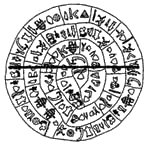 (2 thyrsi, Side 2, connected) which is "any straight line drawn through the centre and terminated in both directions by the circumference of the circle, and such a straight line also bisects the circle. The extremities of a line are points." (14)
(2 thyrsi, Side 2, connected) which is "any straight line drawn through the centre and terminated in both directions by the circumference of the circle, and such a straight line also bisects the circle. The extremities of a line are points." (14)
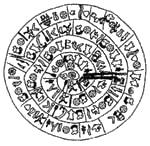 (2 E's, Side 1, 2 Thyrsi connected), or parallel and of different magnitude
(2 E's, Side 1, 2 Thyrsi connected), or parallel and of different magnitude 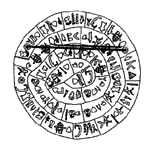 (2 water-vases, 2 hand shields connected) or of the same magnitude but not parallel.
(2 water-vases, 2 hand shields connected) or of the same magnitude but not parallel. 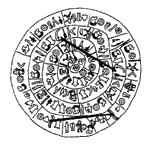 (2 skiffs, 2 Niles signs connected).
(2 skiffs, 2 Niles signs connected).
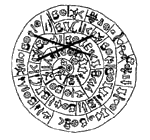 (2 Bull's feet, 2 Falcons on the perch connected) "If two straight lines cut one another, they make the vertical angles equal to one another." (16)
(2 Bull's feet, 2 Falcons on the perch connected) "If two straight lines cut one another, they make the vertical angles equal to one another." (16)
 (2 Isis, 2 Persea fruit connected),
(2 Isis, 2 Persea fruit connected),  (4 sweeps connected) two angles in the same plane which have a common vertex and a common side but have no interior points in common.
(4 sweeps connected) two angles in the same plane which have a common vertex and a common side but have no interior points in common. 
![]() is that which has its three sides equal, an isosceles triangle
is that which has its three sides equal, an isosceles triangle  (3 Papyrus connected) "that which has two of its sides alone equal, and a scalene triangle "
(3 Papyrus connected) "that which has two of its sides alone equal, and a scalene triangle " (3 Marsh Grass connected)
(3 Marsh Grass connected) (3 Papyrus connected) that which has its three sides unequal.
(3 Papyrus connected) that which has its three sides unequal.
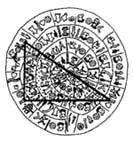 (3 Coffin-chests) "is that which has a right angle, an obtuse-angled triangle"
(3 Coffin-chests) "is that which has a right angle, an obtuse-angled triangle"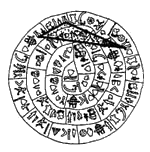 (3 Coffin-Chests
(3 Coffin-Chests 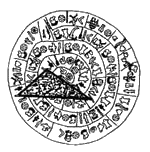 (3 Pi signs) "that which has an obtuse angle, and an acute-angled triangle"
(3 Pi signs) "that which has an obtuse angle, and an acute-angled triangle" 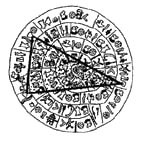 (3 Triangle Fruit connected) that which has its three angles acute. (17)
(3 Triangle Fruit connected) that which has its three angles acute. (17)
 (4 Honey-clovers connected)
(4 Honey-clovers connected)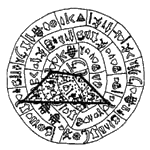 (4 Nile signs) Quadrilaterals may be formed of two triangles.
(4 Nile signs) Quadrilaterals may be formed of two triangles. 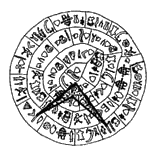 (4 Sceptres)
(4 Sceptres) (4 Sharp-Snout fish connected)
(4 Sharp-Snout fish connected)
 and Canis Major
and Canis Major 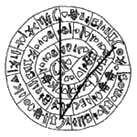
 in which sails the skiff of Isis. The constellation is formed by connecting the skiffs.
in which sails the skiff of Isis. The constellation is formed by connecting the skiffs.
 and Bootes.
and Bootes. 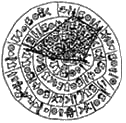
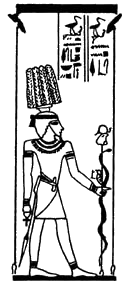 Hermes (Thoth) holds the Rod of Hermes (left), a form of the caduceus like the rod of Moses that was changed into a snake. This rod is topped by the world-sphere--the heaven-sphere or Pleroma of the Egyptian ankh.
Hermes (Thoth) holds the Rod of Hermes (left), a form of the caduceus like the rod of Moses that was changed into a snake. This rod is topped by the world-sphere--the heaven-sphere or Pleroma of the Egyptian ankh.
 seen on the Riddle of the Stone, is P1. The point symbolizes the negative space of Daath (portal).
seen on the Riddle of the Stone, is P1. The point symbolizes the negative space of Daath (portal).
 ...[the] Boundless Point, from which the most minute begins to increase by parts. For the Point which is nothing and is composed of nothing, though partless, will become by means of its own Thought a Greatness beyond our own comprehension. This point is the Kingdom of the Heavens, the 'grain of mustard seed,' the partless point, the first existing for the body; which no one knows save the spiritual alone." (22) (North American Pima Indian basket, left)
...[the] Boundless Point, from which the most minute begins to increase by parts. For the Point which is nothing and is composed of nothing, though partless, will become by means of its own Thought a Greatness beyond our own comprehension. This point is the Kingdom of the Heavens, the 'grain of mustard seed,' the partless point, the first existing for the body; which no one knows save the spiritual alone." (22) (North American Pima Indian basket, left)


 Precept 4. "Its father is the Sun, its mother the Moon; the wind carries it in its belly, its nurse is the earth. The square within the circle is P4.
Precept 4. "Its father is the Sun, its mother the Moon; the wind carries it in its belly, its nurse is the earth. The square within the circle is P4.  These first 4 forms comprise the triangular architecture of Cheops and also demonstrate the negative space that Kabalism calls "daath," and there herein we term "portal."
These first 4 forms comprise the triangular architecture of Cheops and also demonstrate the negative space that Kabalism calls "daath," and there herein we term "portal."






 The original Hermetic Star Sirius within the heptagram of the 7 planets is today the heptagram above, center.
The original Hermetic Star Sirius within the heptagram of the 7 planets is today the heptagram above, center.

















 The priests and priestess of Thoth may have been initiated into these celestial mysteries by aliens from the star system Sirius, where is rumored to be an interstellar gathering place. The Phaistos Disk offers good evidence in substantiation of these beliefs.
The priests and priestess of Thoth may have been initiated into these celestial mysteries by aliens from the star system Sirius, where is rumored to be an interstellar gathering place. The Phaistos Disk offers good evidence in substantiation of these beliefs.
![]() Among the constellations on the Phaistos Disk is a starship between the "Y" and the Cheops sign. In the anti-gravity interior of the starship, seen on a seal excavated at Knossos , are wall-to-wall electronic flight panels and clear glass through which can be seen the constellations.
Among the constellations on the Phaistos Disk is a starship between the "Y" and the Cheops sign. In the anti-gravity interior of the starship, seen on a seal excavated at Knossos , are wall-to-wall electronic flight panels and clear glass through which can be seen the constellations.
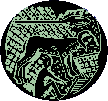
![]() The "Y's," symbolizing Pi, may also symbolize the Y's of the Nazca Plain in Peru. The Nazca Plain is world renown for its 150 square miles of innumerable dead straight lines and huge designs in the soil. Because of the lack of rainfall on the plain, the lines and the drawings, believed to be between 1,500 and 2,500 years old, are permanent. The Phaistos Disk indicates they may be much older, at least 3,600 years old.
The "Y's," symbolizing Pi, may also symbolize the Y's of the Nazca Plain in Peru. The Nazca Plain is world renown for its 150 square miles of innumerable dead straight lines and huge designs in the soil. Because of the lack of rainfall on the plain, the lines and the drawings, believed to be between 1,500 and 2,500 years old, are permanent. The Phaistos Disk indicates they may be much older, at least 3,600 years old.
![]() Many of the designs on the plain appear to be runways for aircraft, giving the impression that the plain was an old spaceport for alien aircraft. Among the designs traced into the dirt of the plain is a huge 4 topped with a vortex. (meaning in mysticism "open channel)
Many of the designs on the plain appear to be runways for aircraft, giving the impression that the plain was an old spaceport for alien aircraft. Among the designs traced into the dirt of the plain is a huge 4 topped with a vortex. (meaning in mysticism "open channel)


 More Phaistos Disk related designs can be seen on the plain. On side 1 of the disk are 5 golden hawks with the Bone of Horus. (left center) When dotted and connected by lines, the golden hawks become the constellation Pavo (The Peacock, left), close to the pole of the Southern Hemisphere and not visible from Crete. The tip of Pavo is produced by connecting the three dogs on Side 1. Pavo is a design seen on the Nazca Plain in Peru. (near left)
More Phaistos Disk related designs can be seen on the plain. On side 1 of the disk are 5 golden hawks with the Bone of Horus. (left center) When dotted and connected by lines, the golden hawks become the constellation Pavo (The Peacock, left), close to the pole of the Southern Hemisphere and not visible from Crete. The tip of Pavo is produced by connecting the three dogs on Side 1. Pavo is a design seen on the Nazca Plain in Peru. (near left)

![]()
![]() They did not land on the plain but engaged in aerial mining, extracting something from the sand and bits of rock. The underlying soil there is a light yellow mixture of sand, clay, and calcite containing angular fragments of reddish rhyolite and other volcanic pebbles. The topsoil is a thin coat of manganese, iron and iron oxides. At the end of the dead straight lines, made by miners flying automatic pilot, are large, "mysterious" piles of rock and sand, mining waste dumped by the miners after they had gleaned from the plain the substance(s) they wanted.
They did not land on the plain but engaged in aerial mining, extracting something from the sand and bits of rock. The underlying soil there is a light yellow mixture of sand, clay, and calcite containing angular fragments of reddish rhyolite and other volcanic pebbles. The topsoil is a thin coat of manganese, iron and iron oxides. At the end of the dead straight lines, made by miners flying automatic pilot, are large, "mysterious" piles of rock and sand, mining waste dumped by the miners after they had gleaned from the plain the substance(s) they wanted.
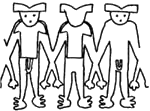
 The plain is perfect for this type of aerial activity because there are no obstacles to low flybys and no chances of being observed except by the Nazca Indians, who would not know what they were witnessing but who might draw it on their pottery. On Nazca Indian pottery are painted some odd looking aliens. (far left)
The plain is perfect for this type of aerial activity because there are no obstacles to low flybys and no chances of being observed except by the Nazca Indians, who would not know what they were witnessing but who might draw it on their pottery. On Nazca Indian pottery are painted some odd looking aliens. (far left)


